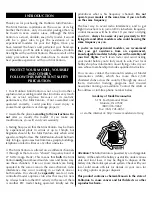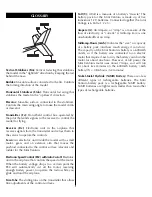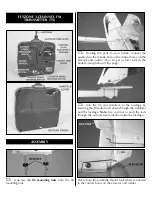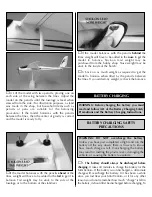
closer in. Allow the MIni Ventura to glide by about ten feet
[3m] in front of you. When it gets too low or after it goes
by add power and do it again. When you are ready to
actually land do the same thing, only this time simply
don’t add power. As the Mini Ventura gets closer to the
ground apply more and more “up” elevator until it slows
to a stop–right on the ground. The propeller will fold back,
preventing damage.
Retrieve the model and make a post-flight inspection by
looking at the propeller, wings and tail for any damage.
If any elevator trim was required, take a look at the
elevator and make a mental note of its position. With
the transmitter on and the battery plugged in, return the
elevator trim tab to center, then bend the pushrod as
shown in step 7, on page 7, until the elevator will be in
the same position it was before you centered the trim.
Do the same with the rudder. The idea is to have the
model fly straight-and-level with the trims centered.
Unplug the battery, then turn the transmitter off. Remove
the battery and allow it to cool before recharging. Allow
the motor to cool before the next flight.
Caution:
If the propeller is ever stuck and cannot rotate
when power is applied, the battery and speed controller
will overheat. Immediately cut the throttle lever to stop
the motor. If you fail to do this, the motor, speed control
and/or battery will be damaged.
In the hands of intermediate or advanced pilots the Mini
Ventura is capable of aerobatics. Among many thrilling
maneuvers, stall turns and loops are fairly easy and fun.
When ready to attempt aerobatics, move the elevator
and rudder pushrods to the inner holes on the control
horns. This will require temporary removal of the fin and
stabilizer so the bends in the pushrods can be guided
out of the holes. The closer in on the control horns that
the clevises are, the more control throw the control
surfaces will have and the more aerobatic the Mini
Ventura will be.
Beginners should not attempt aerobatics until…they are
no longer beginners and are able to react quickly and
get the model out of adverse situations or avoid adverse
situations altogether!
Stall Turn:
First attempts at stall turns should be initiated
with plenty of altitude and with the wind, so that the
maneuver finishes into the wind. Stall turns are best done
off to the left or right of the pilot. Fly the model straight-
and-level under full power. Pull elevator until the model is
vertical. Allow the model to climb vertically while
reducing power to half-throttle. Just before the model
stops its vertical ascent, apply full left rudder until the
model pivots around the wing and is now pointing
downward. Continue the vertical dive until the Mini
AEROBATICS
AFTER FLIGHT
12
















